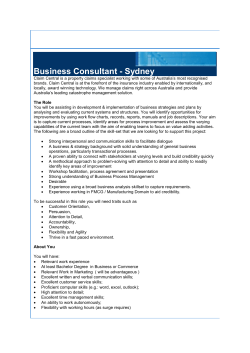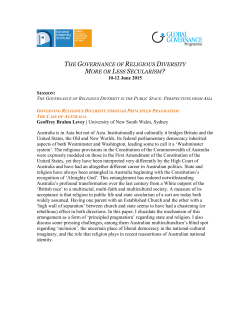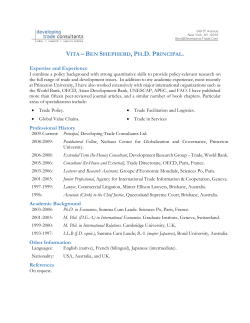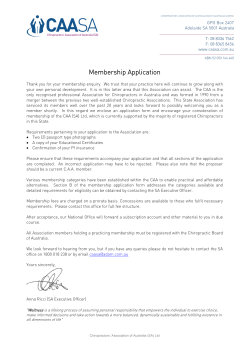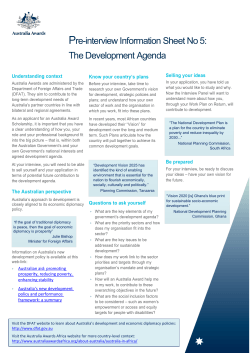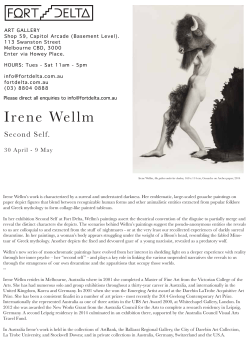
Supporting young children`s rights: Statement of Intent
Supporting young children’s rights: Statement of Intent Tuesday 31 March 2015 Author: Megan Mitchell, Children's Commissioner Good morning and thank you for the introduction. I’d like to start by acknowledging the traditional owners of the land on which we are meeting, and pay my respects to their elders past and present. It’s a pleasure and a privilege to be here today to launch the Statement of Intent on Supporting Young Children’s Rights. Thank you all for coming along. I am very proud of this initiative, which is the result of a highly productive partnership between Early Childhood Australia and the Australian Human Rights Commission. In particular, I want to acknowledge fellow speakers, Samantha Page and Jane Bourne, and all of the members of the ECA National Advisory Group. I also want to extend a very warm welcome to all of the educators, children and any parents, carers and guardians here today. Since I was appointed as Australia’s first National Children’s Commissioner almost exactly two years ago, my priority has been to promote respect for the rights of children in line with Australia’s obligations under the UN Convention on the Rights of the Child. The UN Convention is a human rights treaty which explicitly outlines the rights of children in international law. It provides us with a moral and legal framework for ensuring that all children in Australia can have safe and happy lives. However, to make children’s rights a reality we need to understand them and incorporate them into our daily lives. This is what the Statement of Intent is seeking to achieve. This Statement, which is the product of many months of hard work on the part of ECA Advisory Group members, has been created to support teachers, educators, the community, families and children to comprehend, implement and advocate for children’s rights in early learning and care settings. It is a practical tool to help ensure that early childhood professionals understand Australia’s obligations to children, and to help inform and build on the great work that they do. It also provides high-level principles and areas for collective work, advocacy and action by ECA, its members and me, over the next three years. Embedding rights early on in the lives of children is especially important to ensure their long-term well-being. The UN Committee on the Rights of the Child has outlined the developmental reasons why early childhood is such a critical period for the realisation of children’s rights(1) As many of you are aware: • • • • This is a time when children experience the most rapid period of growth and change during the human lifespan, in terms of their maturing bodies and nervous systems, mobility, communication skills and intellectual capacities, and rapid shifts in their interests and abilities. They form strong emotional attachments to their parents and other caregivers, from whom they seek nurturance, care, guidance and protection. During the early years children establish their own important relationships with other children. Through these relationships they learn to negotiate and share, coordinate activities, resolve conflicts, keep agreements and accept responsibility for others. They actively make sense of the physical, social and cultural dimensions of the world they inhabit, learning progressively from their experiences and interactions. • This is also the time that forms the basis for children’s physical and mental health, emotional security, cultural and personal identity. Young children’s experiences of growth and development vary according to their individual nature, as well as according to things like: living conditions, family organisation, care arrangements and education systems. Their experiences of growth and development are also powerfully shaped by cultural beliefs about their needs and proper treatment, and about their active role in family and community. The importance of early childhood for the health and wellbeing of children and future adults has been recognised by federal, state and territory governments through a number of initiatives that have helped to inform the Statement of Intent, alongside the UN Convention. This include the Early Years Learning Framework, which explicitly incorporates the Convention into this first national curriculum guide for early education and care. Critically, the Statement of Intent has also been directly informed by children and their advocates. Consultations with children in early childhood education and care were led by ECA. Also incorporated were observations made by children about their rights during a national listening tour that I undertook when I started my term as Commissioner in 2013. Through this tour, known as the Big Banter I met with well over 1,000 children face-to-face, and heard from a further 1,400 children online and through the post. I also heard from hundreds of children’s advocates. In each consultation, I asked children and young people, and adults, about the issues that were most important for children and young people, and how we could progress better protection of children’s rights in Australia. One of the most significant things that children and young people told me was that they want have a say in decisions which affect them, and for their views to be taken seriously. For example, one 12 year old told me: Life would be better for children if adults and older people were more open to our ideas and thinking. Another child said: Life would be better for children if they knew that they were safe and their opinion would be heard and taken into account. While there are some great examples of child participation in individual schools and early learning centres, when it comes to respecting the views of the child as a matter of course we can do a whole lot better. This is echoed by the UN Committee on Children's Rights, which has pointed out that Australia has inadequate fora for taking into account the views of children below the age of 15 years in particular. From my perspective, the right of children to be heard and to participate in decisions that impact on them, which is enshrined in article 12 of the Convention, is a gateway to all other rights. This connection was made very clear for me by the links that children made between being able to express their views and feeling and being safe. This is a strong theme emerging from the work of the Royal commission into institutional responses to sexual abuse against children. Children must be seen AND heard in order to be both safe and empowered. The UN Committee has emphasised that as holders of rights, even the youngest children are entitled to express their views. The Statement of Intent explicitly recognises this right and explains what implementing this right would mean for children and for professionals working with children. The Statement also covers other key themes from the Big Banter including the right of children to be free from violence, abuse and neglect, the right of children to thrive and be healthy, and the importance of accountability in our actions towards children. Through this work we have opportunity to change cultural practices and provide all children in Australia with an early sense of their value, agency and belonging. It is never too early to start educating ourselves and children about their rights. As you know children’s learning experiences shape their thinking and values, and children who grow up knowing they are human rights holders will carry the messages of respect and dignity that accompany this knowledge into adulthood. In conclusion, I want to thank you everyone involved in developing the Statement of Intent, especially the ECA National Advisory Group. It’s been fantastic working with all of you. And thank you to everyone for attending today’s launch – as champions of children's rights, I hope that you will use and share the Statement of Intent and that it supports and enhances the work that you do for Australia's most precious resource - our children. Thank you. (1) Committee on the Rights of the Child, General Comment No. 7, Implementing Child Rights in Early Childhood, UN Doc CRC/C/GC/7/Rev.1 (2006), p 3, para 6. At http://tbinternet.ohchr.org/_layouts/treatybodyexternal/Download.aspx?symbolno=CRC%2fC%2fGC%2f7%2fRev.1& Lang=en (viewed 1 October 2014). Address: Lady Gowrie Love Street Community Kindergarten Fortitude Valley QLD 4006 Australia
© Copyright 2025
